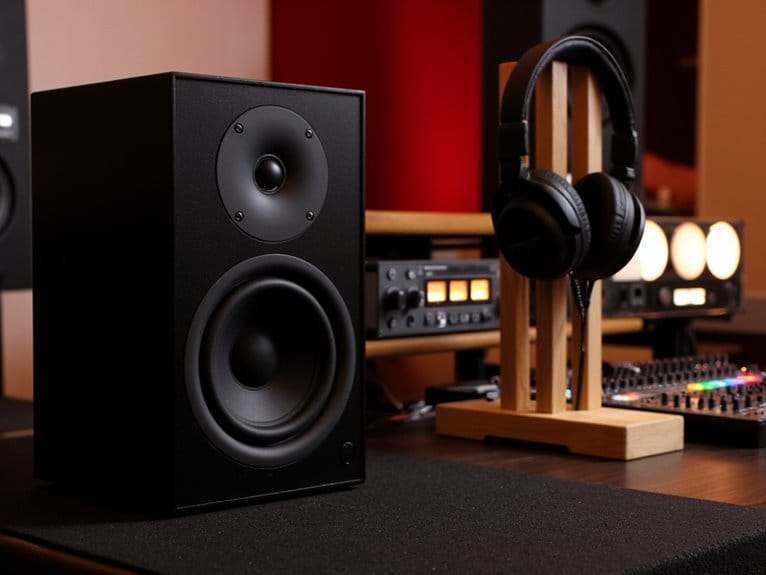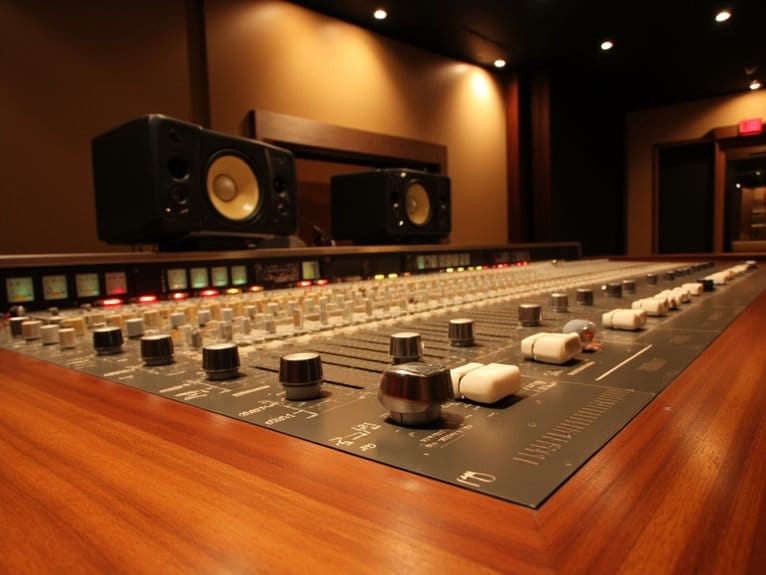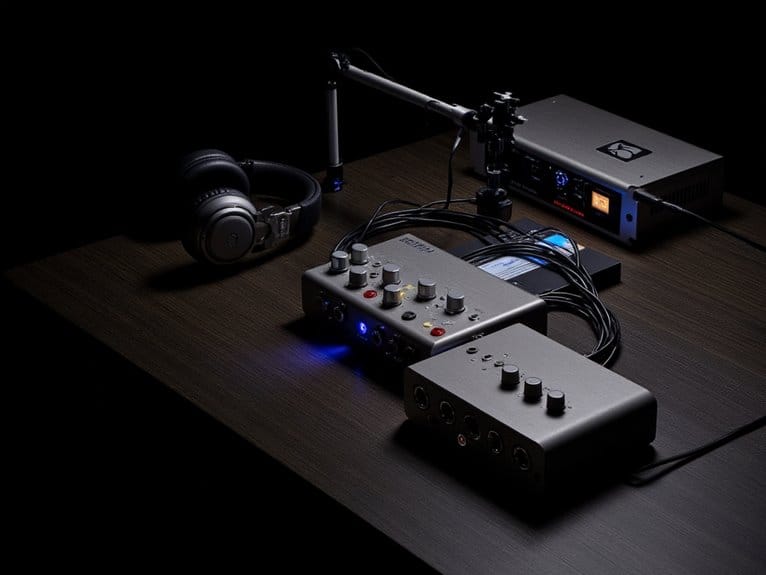Cymbal Alloys: Understanding Materials and Sound Characteristics
Cymbal alloys determine your sound more than you’d expect, with four copper-based materials dominating the market. B20 bronze, containing 80% copper and 20% tin, delivers the warm, complex tones professionals crave, while B8 bronze‘s 92% copper and 8% tin composition produces brighter, cutting sounds with efficient manufacturing. Brass and nickel silver, both tin-free, offer focused highs for budget-conscious drummers, though they sacrifice warmth for accessibility and durability, and understanding these distinctions reveals better purchasing decisions.
We are supported by our audience. When you purchase through links on our site, we may earn an affiliate commission, at no extra cost for you. Learn more.
Notable Insights
- Cymbals use four main copper-based alloys: B8 bronze, B20 bronze, brass, and nickel silver, each producing distinct sound characteristics.
- Higher tin percentages create richer, warmer tones while lower tin content produces brighter, more cutting sounds.
- B20 bronze (80% copper, 20% tin) is the professional standard, delivering complex, warm tones with excellent dynamic range.
- B8 bronze (92% copper, 8% tin) offers bright, cutting sounds with efficient production and high durability for aggressive genres.
- Manufacturing processes like heating cycles and hand hammering significantly influence tonal complexity, brightness, and frequency response of cymbals.
The Four Primary Copper-Based Alloys in Cymbal Manufacturing
When you’re exploring the world of cymbals, understanding the four primary copper-based alloys becomes essential for making informed purchasing decisions, as each material dramatically affects both sound characteristics and durability.
B8 bronze, containing 92% copper and 8% tin, offers bright, cutting tones with exceptional durability, making it perfect for heavy playing styles.
B8 bronze delivers brilliant, penetrating sound with superior strength, ideal for aggressive drummers who demand reliability and projection.
B8 characteristics include enhanced malleability for mass production, which directly impacts cymbal pricing in budget-friendly lines.
Malleable bronze provides balanced tonal qualities between B8’s brightness and bell bronze’s complexity, while brass alloys utilize zinc instead of tin for beginner instruments.
Nickel silver, though rarely used today, combines copper with nickel and zinc.
Manufacturer preferences often favor B8 applications for entry-level products due to cost-effectiveness and consistent quality across automated production processes. Bell bronze follows the traditional 20% tin formula that creates the classic two-phase alloy structure prized in professional cymbals. B20 bronze provides the widest frequency range and superior adaptability across multiple musical genres.
Bell Bronze (B20): The Professional Standard for Premium Sound Quality
The pinnacle of cymbal craftsmanship emerges through bell bronze, or B20 alloy, which combines approximately 80% copper with 20% tin to create what I consider the gold standard for professional cymbal manufacturing.
This two-phase alloy’s historical significance spans over 400 years, establishing its reputation among manufacturers like Zildjian who’ve perfected the art of cymbal craftsmanship through generations of refinement.
You’ll find B20’s complexity lies in its brittleness, requiring up to 15 heating and rolling cycles during production, followed by meticulous hand hammering that machines simply can’t replicate. The hand-hammered technique creates unique tonal characteristics that ensure each cymbal delivers consistent quality while maintaining its individual sonic fingerprint. The long and time-consuming production process distinguishes B20 cymbals from other alloys that can be processed more efficiently.
The result delivers warm, rich tones with exceptional dynamic range, versatility across jazz, rock, and classical genres, and the durability that professional drummers demand for consistent performance.
Malleable Bronze (B8): Balancing Performance and Manufacturing Efficiency
While B20 bronze represents the pinnacle of cymbal craftsmanship, I’d argue that B8 bronze deserves recognition as the pragmatic workhorse of the cymbal world, offering manufacturers a compelling balance between performance capabilities and production efficiency.
B8 characteristics include 92% copper and 8% tin composition, creating a single-phase alloy that’s surprisingly versatile for cold-rolling processes. You’ll find this eliminates the energy-intensive heating cycles that B20 requires, making production faster and more cost-effective.
B8 cymbals deliver bright, cutting tones that excel in aggressive genres like metal and punk, where projection matters more than nuanced complexity. Though they lack B20’s tonal richness, modern B8 variants have improved remarkably, proving that practical doesn’t mean compromising professional performance. The brighter sounds produced by B8’s lower tin content make these cymbals particularly effective for cutting through dense mixes in live performance settings. The bearing edges of cymbals can significantly alter their tonal brightness, making careful manufacturing crucial for achieving optimal sound projection.
Paiste utilizes B8 alloys in their high-end cymbal lines, demonstrating that this composition can achieve professional-grade results when combined with proper manufacturing techniques. Budget options using B8 construction have shown that harmonic content can be enhanced through careful manufacturing processes, making quality sound accessible without premium pricing.
Brass and Nickel Silver: Alternative Materials for Specialized Applications
Beyond the traditional bronze alloys that dominate professional cymbal manufacturing, I’ve observed how brass and nickel silver have carved out their own specialized niches. These alternatives offer manufacturers and musicians distinct options when specific tonal characteristics or economic considerations take precedence over conventional bronze performance.
Brass applications typically focus on four key areas:
- Educational markets – Cost-effective cymbals for student drum kits
- Practice instruments – Durable options for heavy rehearsal use
- Budget-conscious musicians – Accessible entry points into cymbal ownership
- Specialty percussion – Custom applications requiring specific brightness levels
Nickel silver benefits include enhanced durability and tonal clarity, though you’ll sacrifice the warmth that bronze provides. While these alloys can’t match bronze’s harmonic complexity, they’ve proven invaluable when brightness, affordability, or resistance to wear become your primary concerns. Both materials undergo the same fundamental manufacturing methods as bronze cymbals, utilizing either casting or sheet metal forming processes. Modern manufacturers have adopted hot-rolling techniques that offer faster and more cost-effective production of these alternative alloy cymbals without significantly affecting their final sound quality.
How Alloy Composition Affects Sound Character and Durability
Whether you’re reaching for brass for budget considerations or exploring nickel silver’s unique properties, understanding how different alloy compositions fundamentally shape both sound character and long-term durability becomes paramount when selecting cymbals that’ll serve your musical needs effectively.
The tin percentage directly controls your cymbal’s tonal foundation, with higher concentrations producing warmer, complex sounds while lower amounts yield brighter, cutting tones.
| Alloy Type | Tin Content | Sound Character | Durability | Manufacturing |
|---|---|---|---|---|
| B20 Bronze | 20% | Rich, dark, complex | Harder, more brittle | Hand-crafted methods |
| B8 Bronze | 8% | Bright, cutting | More malleable | Machine production |
| Brass | 0% | Focused highs | Moderate strength | Mass production |
| Nickel Silver | 0% | Unique brightness | Good resilience | Specialized forming |
| Bell Bronze | 20% | Full frequency range | Professional grade | Traditional techniques |
Sound sustainment improves greatly with proper alloy selection, as the copper-to-tin ratio regulates both mechanical properties and tonal complexity. Beyond the basic alloy composition, the shaping process through repeated heating and hammering further develops the cymbal’s tonal characteristics and frequency response. B20 bronze offers exceptional versatility in treatment to achieve either bright or dark tonal qualities despite its naturally rich character.
On a final note
You’ll find that choosing the right cymbal alloy ultimately depends on your specific musical needs, budget constraints, and tonal preferences. Whether you’re drawn to B20’s complex overtones, B8’s bright projection, or brass’s affordability, understanding these material differences empowers you to make informed decisions. Don’t let technical specifications overwhelm you—trust your ears, consider your playing style, and remember that even professional drummers often mix different alloys within their cymbal setups.





